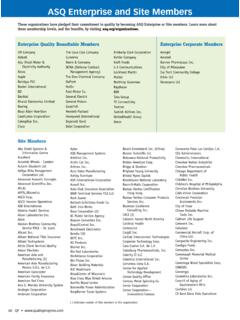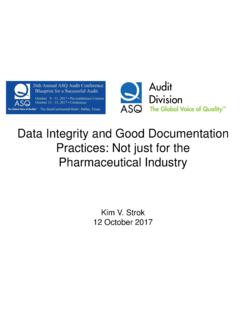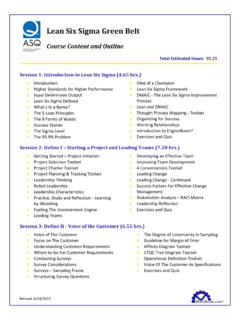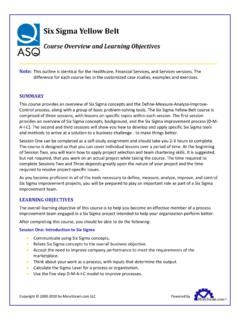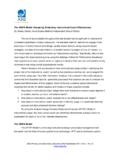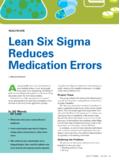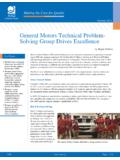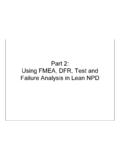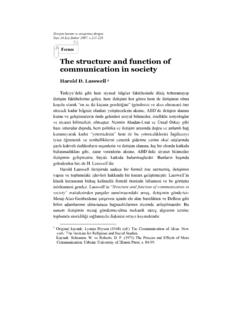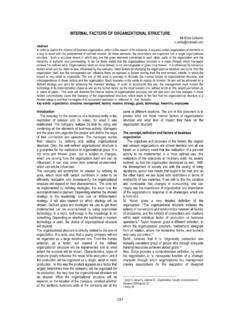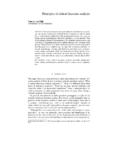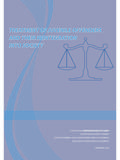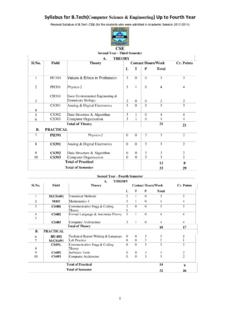Transcription of AMERICAN SOCIETY FOR QUALITY SIX SIGMA BLACK BELT …
1 AMERICAN SOCIETY FOR QUALITY . SIX SIGMA BLACK BELT. BODY OF KNOWLEDGE. The topics in this Body of Knowledge include additional detail in the form of subtext explanations and the cognitive level at which the questions will be written. This information will provide useful guidance for both the Examination Development Committee and the candidates preparing to take the exam. The subtext is not intended to limit the subject matter or be all-inclusive of what might be covered in an exam. It is meant to clarify the type of content to be included in the exam. The descriptor in parentheses at the end of each entry refers to the maximum cognitive level at which the topic will be tested.
2 A more complete description of cognitive levels is provided at the end of this document. I. Enterprise-Wide Deployment [9 Questions]. A. Enterprise-wide view 1. History of continuous improvement Describe the origins of continuous improvement and its impact on other improvement models. (Remember). 2. Value and foundations of Six SIGMA Describe the value of Six SIGMA , its philosophy, history and goals. (Understand). 3. Value and foundations of Lean Describe the value of Lean, its philosophy, history and goals. (Understand). 4. Integration of Lean and Six SIGMA Describe the relationship between Lean and Six SIGMA . (Understand). 5. Business processes and systems Describe the relationship among various business processes (design, production, purchasing, accounting, sales, etc.)
3 And the impact these relationships can have on business systems. (Understand). 6. Six SIGMA and Lean applications Describe how these tools are applied to processes in all types of enterprises: manufacturing, service, transactional, product and process design, innovation, etc. (Understand). B. Leadership 1. Enterprise leadership responsibilities Describe the responsibilities of executive leaders and how they affect the deployment of Six SIGMA in terms of providing resources, managing change, communicating ideas, etc. (Understand). 2. Organizational roadblocks Describe the impact an organization's culture and inherent structure can have on the success of Six SIGMA , and how deployment failure can result from the lack of resources, management support, etc.
4 ; identify and apply various techniques to overcome these barriers. (Apply). 3. Change management Describe and use various techniques for facilitating and managing organizational change. (Apply). Page 1 of 12. 4. Six SIGMA projects and kaizen events Describe how projects and kaizen events are selected, when to use Six SIGMA instead of other problem-solving approaches, and the importance of aligning their objectives with organizational goals. (Apply). 5. Six SIGMA roles and responsibilities Describe the roles and responsibilities of Six SIGMA participants: BLACK belt, master BLACK belt, green belt, champion, process owners and project sponsors. (Understand). II. Organizational Process Management and Measures [9 Questions].
5 A. Impact on stakeholders Describe the impact Six SIGMA projects can have on customers, suppliers and other stakeholders. (Understand). B. Critical to x (CTx) requirements Define and describe various CTx requirements (critical to QUALITY (CTQ), cost (CTC), process (CTP), safety (CTS), delivery (CTD), etc.) and the importance of aligning projects with those requirements. (Apply). C. Benchmarking Define and distinguish between various types of benchmarking, including best practices, competitive, collaborative, etc. (Apply). D. Business performance measures Define and describe various business performance measures, including balanced scorecard, key performance indicators (KPIs), the financial impact of customer loyalty, etc.
6 (Understand). E. Financial measures Define and use financial measures, including revenue growth, market share, margin, cost of QUALITY (COQ), net present value (NPV), return on investment (ROI), cost- benefit analysis, etc. (Apply). III. Team Management [16 Questions]. A. Team formation 1. Team types and constraints Define and describe various types of teams ( , formal, informal, virtual, cross- functional, self-directed, etc.), and determine what team model will work best for a given situation. Identify constraining factors including geography, technology, schedules, etc. (Apply). 2. Team roles Define and describe various team roles and responsibilities, including leader, facilitator, coach, individual member, etc.
7 (Understand). 3. Team member selection Define and describe various factors that influence the selection of team members, including required skills sets, subject matter expertise, availability, etc. (Apply). Page 2 of 12. 4. Launching teams Identify and describe the elements required for launching a team, including having management support, establishing clear goals, ground rules and timelines, and how these elements can affect the team's success. (Apply). B. Team facilitation 1. Team motivation Describe and apply techniques that motivate team members and support and sustain their participation and commitment. (Apply). 2. Team stages Facilitate the team through the classic stages of development: forming, storming, norming, performing and adjourning.
8 (Apply). 3. Team communication Identify and use appropriate communication methods (both within the team and from the team to various stakeholders) to report progress, conduct milestone reviews and support the overall success of the project. (Apply). C. Team dynamics Identify and use various techniques ( , coaching, mentoring, intervention, etc.) to overcome various group dynamic challenges, including overbearing/dominant or reluctant participants, feuding and other forms of unproductive disagreement, unquestioned acceptance of opinions as facts, groupthink, floundering, rushing to accomplish or finish, digressions, tangents, etc. (Evaluate). D. Time management for teams Select and use various time management techniques including publishing agendas with time limits on each entry, adhering to the agenda, requiring pre-work by attendees, ensuring that the right people and resources are available, etc.
9 (Apply). E. Team decision-making tools Define, select and use tools such as brainstorming, nominal group technique, multi-voting, etc. (Apply). F. Management and planning tools Define, select and apply the following tools: affinity diagrams, tree diagrams, process decision program charts (PDPC), matrix diagrams, interrelationship digraphs, prioritization matrices and activity network diagrams. (Apply). G. Team performance evaluation and reward Measure team progress in relation to goals, objectives and other metrics that support team success and reward and recognize the team for its accomplishments. (Analyze). IV. Define [15 Questions]. A. Voice of the customer 1. Customer identification Segment customers for each project and show how the project will impact both internal and external customers.
10 (Apply). Page 3 of 12. 2. Customer feedback Identify and select the appropriate data collection method (surveys, focus groups, interviews, observation, etc.) to gather customer feedback to better understand customer needs, expectations and requirements. Ensure that the instruments used are reviewed for validity and reliability to avoid introducing bias or ambiguity in the responses. (Apply). 3. Customer requirements Define, select and use appropriate tools to determine customer requirements, such as CTQ flow-down, QUALITY function deployment (QFD) and the Kano model. (Apply). B. Project charter 1. Problem statement Develop and evaluate the problem statement in relation to the project's baseline performance and improvement goals.

